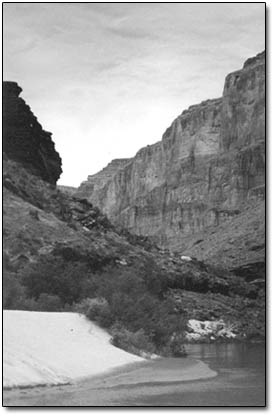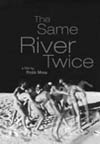|
River runner group seeks end to motor rigs, permit
system
by Missy Votel
 |
The sun sets behind the cliffs
overlooking one of the many sandy beaches along the Colorado
River in the Grand Canyon. The National Park Service is currently
revamping the Colorado River Management Plan, the document
that governs use along the river in the canyon. One private
boater group is calling for increased public access, wilderness
designation and an end to motorized
craft./Photo by Missy Votel. |
More than 130 years ago, John Welsey Powell led nine men down
the uncharted waters of the Colorado River through the Grand Canyon
– a trip so treacherous that three expedition members hiked
out rather than face the river’s wrath. And while Powell
may have had trouble recruiting volunteers, today there are more
than enough to go around.
At last count, there were some 8,200 people waiting to secure
a private launch date, and according to the National Park Service,
newcomers can expect to wait about 20 years for their number to
come up.
And while some see the quarter-century wait as just a law of
supply and demand, one group has dedicated itself to changing
the permit allocation system, one which they say favors commercial
outfitters and the rich while degrading the corridor’s wilderness
qualities.
According to Tom Martin, co-founder of River Runners for Wilderness,
a Flagstaff-based nonprofit group dedicated to obtaining wilderness
status for Grand Canyon National Park and overhauling the permit
system, a typical guided commercial trip costs more than six times
that of a private trip.
“It costs between $275 and $325 a day on a commercial trip,
versus an average of $45 a day for a private trip,” he said.
Speaking to the exclusive nature of commercial trips, he added:
“Half of the passengers on commercial trips make up the
top 12 percent of the country’s earners.”
Take a number
For the remaining percentage, the option is to take a number
and wait, he said. However, under the National Park Service permit
system, only one-third of all river-user days are allocated to
private river runners, with two-thirds going to the commercial
outfitters.
And this is what rankles Martin and members of his group.
“The waiting list is so long, those at the bottom of the
list will wait an incredible 20 years,” he said. “The
vast majority of permits go out to commercial concessionaires,
and the boating public is left behind with no reasonable access.
What is at stake is public access to the greatest river trip in
the world.”
According to Martin, who worked as a commercial river guide for
several years and has authored Grand Canyon guide books, the goal
of his group is not to do away with commercial trips but to ensure
“fair and equitable wilderness access.” Martin acknowledges
that wilderness designation would likely mean an end to motor
rigs in the canyon. However, he thinks banning motors is a “no
brainer” when it comes to preserving a natural wonder like
the Grand Canyon.
“There’s only one Colorado River and Grand Canyon,”
he said. “There’s nothing like it in the world.”
And while the prospect of prohibiting motor rigs may be wildly
unpopular among commercial outfitters, Martin said he thinks it
will barely make a ripple among the river-running public.
“Studies have proven that the public, when given an option,
prefer oar trips over motorized ones,” he said. “Nobody
is saying motor trips are better.”
As far as the permitting process goes, Martin’s group is
proposing one that would “front load” the system,
whereby people would secure permits and then decide from there
whether they would like to hire a company to guide them or do
it themselves.
“It would follow the demand of the public, permit for permit,”
he said, adding that a similar system is in place – and
successful – in the Boundary Waters Canoe Area Wilderness
in northern Minnesota.
And with the Colorado River Management Plan – the document
governing use of the river through the Grand Canyon – up
for revisal, now is the time for river runners to unite, according
to Martin.
“We’re canvassing the country,” he said, adding
that Colorado has the highest number of people on the private
launch waiting list. “We’re trying to drive home the
message and get people to write their congressmen and participate
in the management plan.”
 More
ways to get a Grand fix... More
ways to get a Grand fix...
Tim Martin, author of Day Hikes
From the River: A Guide to 100 Hikes from Camps on the Colorado
River in Grand Canyon and founder of River Runners for Wilderness,
will present a free slideshow and Grand Canyon management
plan update on Sunday, Nov. 30, at 6:30 p.m. at the Abbey
Theatre.
The slideshow will be followed by an 8:30 p.m. screening
of “The Same River Twice,” an award-winning
documentary that revisits a group of Grand Canyon river
guides 20 years after a pivotal monthlong trip down the
canyon.
The film, by Rob Moss, follows a free-spirited group of
friends and lovers on a month-long trip down the Colorado
River. Cutting between footage of their youthful, often
naked, unscheduled lives and the complex realities of their
adulthood today, the film creates a compelling portrait
of cultural metamorphosis. From running rapids to running
for mayor, “The Same River Twice” is a story
of change, choices and finding one’s place in the
world.
The event is sponsored by River Runners for Wilderness,
Weminuche Chapter of the Sierra Club, Taxpayers for the
Animas, and the Abbey Theatre. For more information call
385-1711.
|
In defense of motors
At least one river-user group doesn’t see eye to eye with
River Runners for Wilderness. The Grand Canyon River Outfitters
Association, which is made up of 16 commercial companies running
trips in the canyon, does see a need to protect the Grand Canyon
and find an end to the controversy, but it takes issue with some
of Martin’s goals.
For starters, the group would like to see wilderness designation
for the Grand Canyon with the exception of the river corridor,
which it sees as a main access route to the backcountry. Furthermore,
the group asserts that motor rigs do not adversely impact the
environment.
“Motorized use is transitory in nature and does not harm
or negatively impact the resources,” the group states on
its web site. If the practice was harmful, it argues, then it
would have become apparent over the last 50 years of motorized
use. However, wilderness advocates maintain that the corridor
is suitable for wilderness, which can only mean “motorized
use has not diminished 85 wilderness character.”
The outfitter’s group also turns Martin’s access
argument on its head, pointing out that three out of four commercial
passengers depend upon motorized craft for their trips.
“Such motorized access is essential in order to provide
the current level of public access,” the group states, adding
that a ban on motorized craft could drastically decrease public
availability of commercial trips.
“The number of passengers able to take these trips could
be reduced from 19,000 to as little as 8,000 or 9,000 annually,”
the group writes.
The outfitters association also points to its environmental stewardship
record as a defense. According to the group, five years ago, members
began changing over from two-stroke engines to cleaner and quieter
four-stroke engines. The group also has launched a research project,
with the intent of eventually developing an electric, zero-emissions
motor. 4
As far as permits go, the outfitter association advocates a “Real
People/Real Trip Dates” system whereby private boaters reserve
a specific date for a specific number of people and specific number
of days. The group predicts that the reservation system, which
is based on travel industry practices, coupled with an increase
in allocations, could produce an average wait for a private trip
of 12 to 20 months.
“A reservations-based management model offers great promise
to provide access to the Grand Canyon river experience for the
self-guided river trip participant on par with what professionally
outfitted patrons currently enjoy,” the group states.
Changing the system
And while both sides of the motor rig issue argue their cases,
the National Park Service will have the final say in the matter.
According to Linda Jalbert, recreation wilderness planner at
Grand Canyon National Park, the management plan is still in the
environmental impact study phase.
“We are currently working on the impact analysis of alternatives
as required by (the National Enivironmental Protection Act),”
she said.
A scoping period to gauge public opinion on the new management
plan was held last summer, including public meetings in Denver,
Flagstaff and Salt Lake City. The resulting draft EIS is expected
by early next year, which will be followed by another comment
period and more public meetings. The final EIS will be released
at the end of 2004.
“The draft EIS is a critical step,” she said. “That
is where we go to the public and look for public comment.”
Although Jalbert couldn’t specify what alternatives are
being discussed for the management plan, she did say that the
Parks Service is analyzing lower-use alternatives as well as a
non-motorized alternative and a “do-nothing” alternative,
as required by law. She said that last summer’s scoping
process netted more than 50,000 comments from more than 15,000
people. And while the comments were all over the board, she said
there was consensus on the failure of the permit system.
“The general feeling was that we need to change the system,
it’s pretty unpopular,” she said. “We just don’t
know what we’re going to change it to.”
And while parties on both sides of the issue await the final
decision, they expressed optimism over the ability to reach an
amicable resolution.
“Those who have been down the river realize the comradeship
among the groups, often helping one another if need be,”
the outfitters association wrote. “Yet in addressing the
allocation issue and the issue of access for private boaters,
we all must appreciate that the NPS must manage 85 in the overall
public interest.”
Likewise, Martin, with River Runners for Wilderness, expressed
hope in finding common ground and improving the contentious situation.
“We are problem solvers,” he said. “Given half
a chance, we can do way better.”
|

